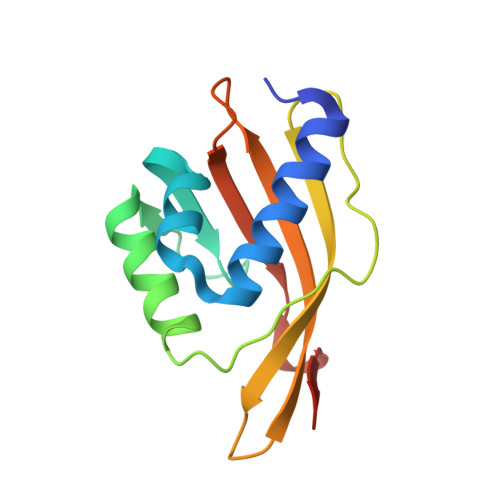High-Resolution Crystal Structures of Delta5-3-Ketosteroid Isomerase with and without a Reaction Intermediate Analogue
Kim, S.-W., Cha, S.-S., Cho, H.-S., Kim, J.-S., Ha, N.-C., Cho, M.-J., Joo, S., Kim, K.-K., Choi, K.-Y., Oh, B.-H.(1997) Biochemistry 36: 14030
- PubMed: 9369474
- DOI: https://doi.org/10.1021/bi971546+
- Primary Citation of Related Structures:
1OH0, 1OPY - PubMed Abstract:
Bacterial Delta5-3-ketosteroid isomerase (KSI) catalyzes a stereospecific isomerization of steroid substrates at an extremely fast rate, overcoming a large disparity of pKa values between a catalytic residue and its target. The crystal structures of KSI from Pseudomonas putida and of the enzyme in complex with equilenin, an analogue of the reaction intermediate, have been determined at 1.9 and 2.5 A resolution, respectively. The structures reveal that the side chains of Tyr14 and Asp99 (a newly identified catalytic residue) form hydrogen bonds directly with the oxyanion of the bound inhibitor in a completely apolar milieu of the active site. No water molecule is found at the active site, and the access of bulk solvent is blocked by a layer of apolar residues. Asp99 is surrounded by six apolar residues, and consequently, its pKa appears to be elevated as high as 9.5 to be consistent with early studies. No interaction was found between the bound inhibitor and the residue 101 (phenylalanine in Pseudomonas testosteroni and methionine in P. putida KSI) which was suggested to contribute significantly to the rate enhancement based on mutational analysis. This observation excludes the residue 101 as a potential catalytic residue and requires that the rate enhancement should be explained solely by Tyr14 and Asp99. Kinetic analyses of Y14F and D99L mutant enzymes demonstrate that Tyr14 contributes much more significantly to the rate enhancement than Asp99. Previous studies and the structural analysis strongly suggest that the low-barrier hydrogen bond of Tyr14 (>7.1 kcal/mol), along with a moderate strength hydrogen bond of Asp99 ( approximately 4 kcal/mol), accounts for the required energy of 11 kcal/mol for the transition-state stabilization.
Organizational Affiliation:
Department of Life Science and School of Environmental Engineering, Pohang University of Science and Technology, Pohang, Kyungbuk, 790-784, South Korea.
















